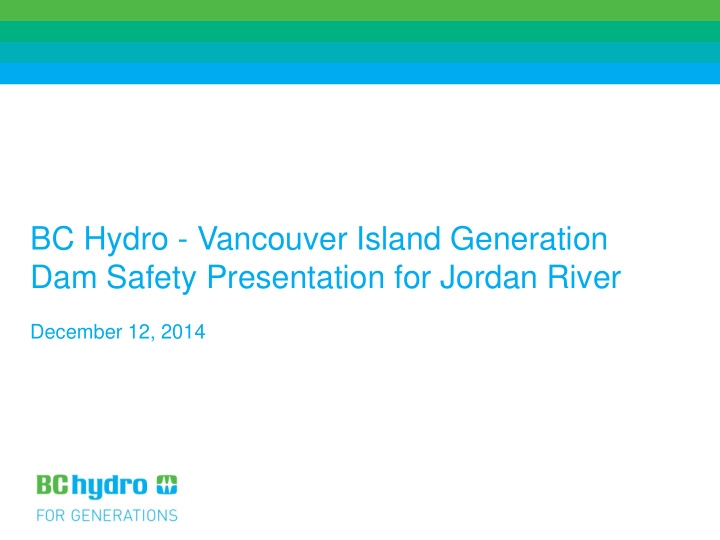



BC Hydro - Vancouver Island Generation Dam Safety Presentation for Jordan River December 12, 2014
BC HYDRO DAM SAFETY PROGRAM • 41 dam facilities province-wide in 23 watersheds • Ongoing dam safety studies and modelling, maintenance and upgrades • Near real-time dam safety monitoring, including 24/7 monitoring, and weekly visual inspections by crews • Semi-annual inspections; independent reviews (7 – 10 years) • 2013 Independent Dam Safety Audit Go to www.bchydro.com/damsafety 2
NEW SEISMIC HAZARD MODEL • Updated model provided better understanding of ground motion and hazard for all BC Hydro dams. Previous models outdated. • First hydroelectric utility in North America to develop the rigorous, best-in-class seismic hazard model. Comparable to process used by nuclear industry. • Six years of research by BC Hydro and international experts 3
WHY NEW RESEARCH? • What has changed since then? • More data • Improved understanding of B.C. seismotectonics • Ground motion models 4
THE CASCADIA SUBDUCTION ZONE 5
IMPACT ON SYSTEM 6
BC HYDRO SEISMIC SAFETY IMPACT ON SYSTEM 7
IMPACT ON SYSTEM – ALL EARTHQUAKES Bear Creek Jordan Elliott 8
JORDAN DIVERSION DAM 40m high 230m long Current seismic withstand = 0.45g 9
CONCRETE BUTTRESS DAM 10
1990’S UPGRADES 11
CASCADIA EARTHQUAKE EVENTS 12
ASSESSMENT / CONSIDERATIONS 1. Upgrade Further or Replace 2. Lower the reservoir or Decommission 13
DAM DESIGN LEVELS Chance per year Ground Motion (g) 1 in ten thousand 1.5 CDA Guideline 1 in a thousand 0.9 Feasible Upgrade 1 in 500 0.37 Current Withstand about 0.45g 14
JORDAN RIVER ELECTRIC SYSTEM • Bear Creek Dam (1912) • Upgrades in the 1970s/1990, including seismic • Jordan River Diversion Dam (1913) • New powerhouse (1971), extensive upgrades in 1958,1971 and 1991, including seismic • Elliot Dam (1970) • Used as needed to provide electricity during peak use hours for Southern Vancouver Island and to support transmission line outages. • System supplies about 10% of the Island’s needs. 15
VANCOUVER ISLAND TRANSMISSION 16
JORDAN RIVER FINDINGS • In a major earthquake resulting in structural damage to buildings, immediate downstream evacuation will be critical. • In a worst-case scenario where the dam is jeopardized or fails, water could arrive into the inundation zone as quickly as 20 minutes; a tsunami could arrive in 45 minutes. 17
18
NEXT STEPS • Work with local residents, businesses, First Nations and local authorities to: • Improve local emergency planning/awareness • Ensure businesses and recreational interests can continue to operate • Limit future development within evacuation area • Offer to purchase homes 19
Recommend
More recommend